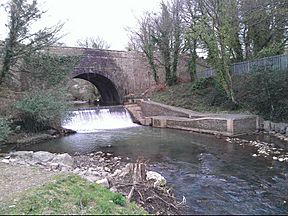Afon Lwyd facts for kids
Quick facts for kids Afon Lwyd |
|
|---|---|

The Afon Lwyd weir and fish leap at Pontymoile. The bridge carries the Monmouthshire and Brecon Canal.
|
|
| Other name(s) | Afon Llwyd |
| Country | Wales |
| Region | South East Wales |
| District | Torfaen |
| Physical characteristics | |
| Main source | Blaenavon, Torfaen, Wales |
| Discharge (location 2) |
|
| Basin features | |
| Tributaries |
|
The Afon Lwyd is a river in south-east Wales. Its name means 'grey river' in Welsh. It flows for about 13 miles (21 km). The river starts north of Blaenavon. It then flows through towns like Abersychan, Pontypool, and Cwmbran. Finally, it joins the River Usk at Caerleon. The Usk then flows into the Bristol Channel near Newport.
The river used to be very polluted. Factories and mines released waste into it. People also dumped rubbish. But in the 1980s, efforts began to clean it up. The goal was to improve the water quality. They also wanted more fish to live there. In 2010, the Environment Agency Wales built a special fish ladder. It is at Pontymoile. This ladder helps fish swim past a small dam (called a weir). By late 2011, the river was much cleaner. It was said to be the cleanest it had been since medieval times.
Historically, the river was also called the Torfaen. This name means 'breaker of stones'. It shows how strong the river could be during floods. This name is no longer used for the river itself. However, it is still the name for the local council, Torfaen County Borough Council.
Contents
Why Does the Afon Lwyd Flood?
The area where the river flows can get a lot of rain. Also, local towns affect how water runs off the land. Because of this, the river can quickly become very fast. Small, sudden floods are not uncommon. The last big flood of the river happened in the 1930s.
How Are People Helping the River?
Since March 2010, a group called Friends of Afon Llwyd (FOAL) has been working to help the river. This project is a partnership. It includes the Torfaen County Borough Council. It also includes two local fishing clubs. Their main goal is to make the river a better home for fish. They want to help fish like salmon, sea trout, and brown trout.
The Wye and Usk Foundation also received money for river projects. They got £130,000. This money helps them remove harmful weeds. They also manage river bank erosion. They create fish ladders and improve community involvement. Nearly £750,000 has been spent or will be spent on improving the river.
A big part of the FOAL project was to lower a weir at Ty Nant Ddu, Pontypool. This weir used to block fish from swimming upstream. In 2008, salmon were seen there. Similar work was done at a weir near Cwmavon. To help fish numbers grow, special 'V' shaped weirs were built. These weirs trap gravel. This creates good places for fish to lay their eggs.
At the river's source in Blaenavon, volunteers are also helping. They are part of the Conservation Volunteers and Forgotten Landscapes Partnership. They are making the river area greener. This part of the river runs through the Blaenavon World Heritage Site.
What About the American Crayfish?
The river has a problem with an invading species. It is called the American signal crayfish. This crayfish is harming the native white-clawed crayfish. The American crayfish not only competes for food. It also carries a disease called crayfish plague. The native white-clawed crayfish cannot fight off this disease.
Exploring the Afon Lwyd Trail
The Afon Lwyd Trail is a path for walking and cycling. It is about 16 miles (26 km) long. The trail starts at Blaenavon Ironworks in the north. It goes through Pontypool and ends in Cwmbran in the south. The path first follows the Monmouthshire and Brecon Canal. Then, it uses part of an old railway line. The trail includes two National Cycle Network routes. These are routes 49 and 492.

